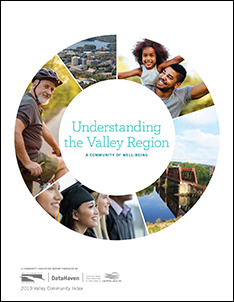 DERBY, CT -- While the Valley has a long history of being a close-knit, family-centered region, disparities among its communities present both challenges and opportunities in addressing health and wellness needs. In partnership with Griffin Hospital and the Naugatuck Valley Health District, more than 40 representatives from a range of multi-disciplinary organizations collaborated to examine well-being and socioeconomic data in the Valley. The findings are featured in the 2019 Valley Community Index, which was released along with its executive summary at a community event in Shelton on Tuesday October 22nd. The report available online at www.valleyfoundation.org.
DERBY, CT -- While the Valley has a long history of being a close-knit, family-centered region, disparities among its communities present both challenges and opportunities in addressing health and wellness needs. In partnership with Griffin Hospital and the Naugatuck Valley Health District, more than 40 representatives from a range of multi-disciplinary organizations collaborated to examine well-being and socioeconomic data in the Valley. The findings are featured in the 2019 Valley Community Index, which was released along with its executive summary at a community event in Shelton on Tuesday October 22nd. The report available online at www.valleyfoundation.org.
“Information that is understandable and easily accessible is a key component of high-quality, cost-effective decision making,” said Sharon Closius, Valley Community Foundation President & CEO. “The 2019 Valley Community Index aims to help local leaders understand and proactively address issues impacting the health and well-being of our communities. The more that we know about our region, the better we are able to engage with each other in meaningful dialogues about the pulse of the Valley and what actions are needed to create a more vibrant community.”
This report reflects the most recent data collection efforts to examine the social, economic, and physical health of the Valley’s populations and updates the 2016 Community Index report with new information. The takeaway most reinforced is that health and well-being are not simply about genetics, but are impacted by factors both within and beyond one’s control. Social determinants of health such as diet, smoking, exercise as well as access to a range of services, transportation, employment, public safety, and more, can have a lasting impact on quality of life.
Created in partnership with DataHaven, the 2019 Valley Community Index is a single-source report that provides timely, comprehensive socioeconomic, education, health, and well-being data that is shaping this seven-town region. The Index meets Griffin Hospital’s IRS requirements in Form 990 Schedule H and Notice 2011-52 that discuss the creation of a Community Health Needs Assessment, which all tax-exempt hospitals complete as a result of the Patient Protection and Affordable Care Act. It also fulfills Naugatuck Valley Health District’s requirement for a Community Health Assessment as part of its national accreditation by the Public Health Accreditation Board. The Index serves as a foundation for the Valley Community Health Improvement Plan (CHIP), a requirement for both Griffin Hospital and NVHD.
The 2019 Valley Community Index will be used to convene community conversations, foster engagement, align current efforts and investments, and collaborate on strategic endeavors to build, sustain, and enhance the quality of life in the Valley.
Key findings from the 2019 Valley Community Index include:
- Between 2015 and 2035, the Valley’s senior population is projected to increase by 39% - nearly twice as fast as the projected growth for seniors statewide.
- The Valley’s four-year graduation rate increased from 83% in 2011 to 90% in 2017.
- Throughout the past four years, the Valley’s statewide standardized test pass rate for math increased from 37% to 51%.
- In 2017, 53% of 3 to 4-year-olds were enrolled in preschool compared to 64% enrolled throughout the state.
- The rate of non-adequate prenatal care in the Valley—meaning that the mother went to fewer than 80% of the expected prenatal care visits or did not start the visits until her second trimester—rose from 11.3 percent of 2006–2010 births (824 infants) to 16.4 percent of 2011–2015 births (1,076 infants). This represents a 45% increase, compared to a 14% statewide increase.
- The rate of low birthweight babies—defined as the percentage of infants born that weigh fewer than roughly five and a half pounds—rose by 3% in the Valley over the past decade, despite falling by 3% statewide. The rate of low birthweight babies in the Valley was higher among Black and Latino mothers than White mothers.
- Between 2015 and 2018, the Valley averaged 30.1 drug overdose deaths per 100,000 residents per year, above the state’s rate of 24.2 per 100,000. Filtered for just opiate- and opioid-related deaths, these rates become 28.8 and 22.8, respectively.
- Between 1980 and 2017, the Valley’s homeownership rate has raised from 68 to 72%. However, there are significant disparities in homeownership between racial and ethnic groups. In 2017, the homeownership rate among White households in the Valley was 78%, but only 41 percent and 48 percent for Black and Latino households.
- Between 2001 and 2004, only 1% of housing units built in the Valley were multi-family; this increased to 39% of units built between 2014 and 2017.
- The Valley’s average unemployment rate from 2013 to 2017 (8%) was similar to the statewide and nationwide rates (both 7%).
2019 Valley Community Index Funders
Funders include: Valley Community Foundation, the Bassett Family Fund, Griffin Health Services Corp., Katharine Matthies Foundation - Bank of America, N.A., Trustee.
Contributing funders include Connecticut Community Foundation and Valley United Way.
About The Valley Community Foundation
Established in 2004, the Valley Community Foundation distributes approximately $1.6 million in grants each year to support the local nonprofit sector and the people it serves. In addition to grantmaking, VCF works in strong partnership with The Community Foundation for Greater New Haven (TCF), to promote philanthropy in Ansonia, Derby, Oxford, Seymour and Shelton and receives funding from The Gates Fund and other preference funds at TCF that benefit the Valley.
###
Contact:
John Ready
Donor Services & Communications Officer
Valley Community Foundation
203-751-9162
jready@valleyfoundation.org
Website: www.valleyfoundation.org